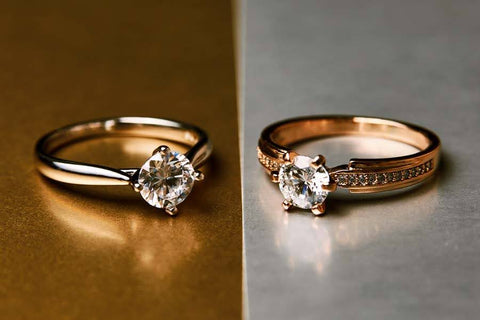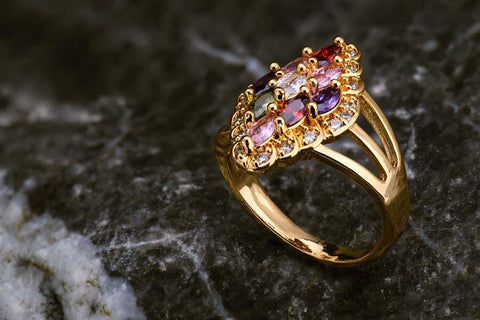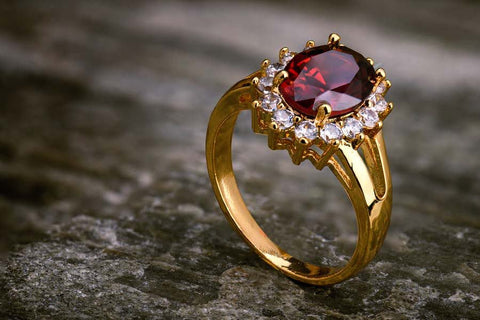by Jesús Zabala - 6 min read
18K vs 24K Gold
Shopping for gold jewelry can be a challenging task, given the wide range of options available. Knowing the difference between each karat piece becomes critical to guide you in the process, as the gold purity significantly influences the durability capabilities, appearance, and feel of the jewelry. Whether you’re drawn to the balanced resilience and shine of 18k vs 24k gold and its unique rich purity, the friendly karat system allows you to make an informed choice, perfectly aligning your preferences.
In this article, we’ll elaborate on how the karat system works and delve into the unique characteristics of 18k and 24k gold. Discover the differences between these two pieces and decide which appearance, price, and maintenance requirements best suit your taste.

Source: shutterstock.com / Photo Contributor: Gecko Studio
Understanding Gold Purity
When searching for gold jewelry, you’ve likely come across the karat system that serves as a friendly guide to understanding the purity of gold in each piece. Although we’re all familiar with the fact that the higher the karat, the more expensive the gold piece will be, have you ever wondered why it is?
The karat system is commonly expressed as a fraction out of 24 karat, with the 24k representing pure gold. In addition to constituting the content of pure gold, these numbers also refer to the quality and the type of gold used to craft a particular piece of jewelry. Therefore, if your jewelry is 10 karat, it’s like having 10 parts of pure gold, which is equivalent to 41.70% of goodness out of 24. The rest of the alloy is composed of other materials that could include base metals such as copper, silver, or palladium.
This system of measuring the amount of pure gold in jewelry allows you to easily understand the actual gold content in various items, including gold plated pieces, which determines their value and durability. With this in mind, 24k pieces have the purest gold content you can purchase. But what is the difference, and which is better, 18k gold or 24k gold?
Characteristics of 18k gold
Firstly, let’s explore the 18k gold pieces' characteristics. At this number of karats, gold takes a special allure, blending purity and resilience. These pieces of jewelry are truly captivating accessories, adding a touch of luxury and elegance while also striking exceptional durability, capabilities, and strength.
Some of the more distinctive characteristics and features of 18k gold pieces are:
- Purity - 18k gold contains 75% pure gold content, giving it a radiant luster.
- Durability - to reinforce its durability, the remaining alloy content of 18k gold comes from copper, silver, or palladium, enhancing the overall strength and endurance.
- Resilience - 18k gold is less prone to tarnish compared to higher karat gold, making it ideal for those seeking lasting pieces.
- High price tag - while it comes at higher price tags than lower karat gold, 18k pieces are favored for fine jewelry.
- Softer feel - due to the purity levels, 18k gold is softer than 14k gold.

Source: shutterstock.com / Photo Contributor: NPDstock
Characteristics of 24k gold
On the other hand, 24k gold is the pinnacle of purity, embracing a radiant brilliance and creating a timeless allure that is hypotonic to the eye. These pieces can elevate any outfit, whether casual or professional, with unparalleled elegance and sophistication while adding a luminous glow and a touch of luxury.
Some of the most recognized characteristics and features of 24k gold include:
- Purity - 24k gold pieces possess the highest karat level of gold, meaning that 99.9% of its content is pure gold.
- Soft and malleable - due to its purity levels, this amount of karats promotes a soft and malleable feel but requires careful handling for intricate designs.
- Alloy-free purity - one of the most distinctive features of 24k is its absence of alloys, embracing the unaltered beauty and value of gold.
- Prone to surface changes - because these pieces are devoid of any alloys, they can experience surface changes over time, including scratches or developing patina.
- Exquisite craftsmanship - since 24k is extremely soft and fragile, intricate, detailed, and delicate designs showcase exquisite craftsmanship, adding to the value and overall impact of these pieces.

Source: shutterstock.com / Photo Contributor: NPDstock
Comparison of 18K and 24K Gold in Terms of Durability
Now that you know the basics of 18k vs 24k gold, understanding their differences is significant in jewelry choices, allowing you to make informed decisions and align your preferences. Below, we’ve provided you with insight into the difference in appearance, price, care, and maintenance considerations between 18k and 24k gold pieces, all of which are important factors to consider when shopping for gold jewelry.
Appearance and color
18k gold pieces exhibit a warm and inviting hue that’s slightly lighter when compared to 24k gold pieces, striking a balance between aesthetics and durability due to the added metals. This alloy combination also embraces several tint or hue variations, ranging from bright yellow, bright white, and peachier rose gold, all of which have risen in popularity, becoming the new trendsetters within the realm of modern jewelry vogue.
On the contrary, 24k gold pieces provide a distinctive color brilliance, embracing an intense and deep yellow hue, highlighting its purity and distinguishing it from other metals. While the tint exhibits a radiant and luxurious appearance, the purity of 24k gold gives the piece a softer texture, making it more prone to wear and tear.
So, when choosing between 18k and 24k gold jewelry, considering the appearance and color disparity, it all comes down to personal preference. Make sure your selection aligns with a piece that not only shines bright but also stands out with practicality and resilience.
Price considerations
When shopping for gold jewelry, it’s important to consider the pricing of 18k vs 24k gold, as it may vary from manufacturer to manufacturer. While the cost is determined by both the piece’s weight and purity, other factors that could influence the overall bill may include:
- Craftsmanship - as the level of craftsmanship directly impacts the final cost of gold jewelry, handcrafted jewelry with intricate designs and complex patterns holds much more value, hence its high price tag.
- Practicality - factors like durability and sustainability of everyday wear can influence the final cost of gold pieces.
- The market demand and value - gold jewelry that aligns with the current trends and styles often comes at a heftier cost due to the increased demand.
- Brand reputation - well-established brands with a long history of exceptional craftsmanship and loyal customers often command higher prices.
While all these factors significantly contribute to gold jewelry’s costs, you’ll likely find that 24k gold typically has the highest price tag per gram or ounce as it has the purest form of gold. 18k gold strikes a balance between purity and durability with its added alloys, hence presenting a more budget-friendly option.
Care and maintenance
Caring for gold jewelry is an essential part of preserving its beauty, luster, and longevity. While there are several ways to maintain gold pieces, the most common practice is cleaning your accessories with mild soap, warm water, and a soft brush. With these tools, you can thoroughly eliminate any buildup from dust, debris, as well as bodily oils.
However, it’s crucial you avoid using any harsh chemicals or rough materials that could scratch or damage the surface or integrity of gold pieces. Make sure you properly store them in fabric-lined jewelry boxes to prevent tangling, tarnish, or harm to the metal. Additionally, you ought to be more careful and gentle with 24k gold as its purity causes the jewelry to be extremely soft and delicate when compared to 18k gold pieces.
Lastly, regular professional cleaning and inspection by jewelers can help you address intricate maintenance requirements. When dealing with high-purity gold, extra care may be necessary to protect it from unwanted discoloration and damage. With these simple care routines, you can ensure your gold jewelry retains its value over time and remains as radiant as ever.

Source: jewelrylab.co
Conclusion
Searching for the perfect gold pieces demands a thorough understanding of the karat system and the distinctive characteristics of each karat-level gold. The distinction between 18k vs 24k gold goes beyond mere numbers, representing the very essence of gold purity and durability, as well as the aesthetic appeal of the pieces.
So, when contemplating whether you want the luxurious allure of 24k gold or the exceptional resilience and unique appeal of 18k gold, make sure you strike a balance between your personal preferences and today’s modern trends and styles. By comparing the two items, you can make an informed decision that not only resonates with your aesthetic but also stands the test of time.
Hopefully, we’ve helped you gain insightful information on these two exceptional gold items, allowing you to select cherished accessories of style and sophistication.
-
DESIGNED & HANDMADE IN BALI
-
FREE RESIZING FOR EVERY PIECE
-
FREE SHIPPING ON $150+ ORDERS
-
100% SAFE & SECURE CHECKOUT























































